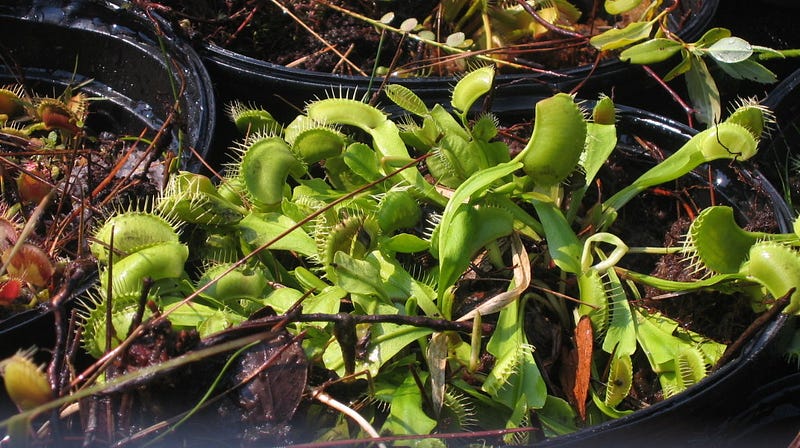This week, we’ll be talking about a plant whose name is well known, but is rarely seen in the wild: Dionaea muscipula, the Venus flytrap. There are a variety of reason for this, including its small size (most videos of the Venus flytrap or similar plants do not provide good scale, so they appear to be larger than they actually are). However, the biggest factor is the size of its overall native range. While it has been widely cultivated as a houseplant, wild individuals can only be found in the coastal bogs of North and South Carolina in the United States.
The Venus flytrap is a carnivorous plant, meaning that it feeds on other animals. The vast majority of plants receive their energy from sunlight via photosynthesis and carnivorous plants do as well. However, plants also require nutrients such as nitrogen and phosphorus, usually acquired from the soil in which they grow. Carnivorous plants tend to live in nutrient poor soils and have thus developed an alternate source for their nutrients: animal protein (normally in the form of insects or other arthropods).
A bog is a type of wetland that accumulates dead plant matter known as peat and they are usually low in both nitrogen and phosphorus, which makes them unsuitable for most normal plants. However, the Venus flytrap can supplement its nutrient diet by capturing flies and other insects in their modified leaves. Tiny hairs on the inner surface of the trap can sense movement and close the structure, trapping the prey and releasing digestive chemicals.

Dionaea muscipula is currently classified as Vulnerable because all wild populations occur within a 75 mile radius of Wilmington, North Carolina. All known sites that have wild individuals are on Nature Conservancy, state government, or US military land (such as the flytraps in the above pictures taken by myself at MCB Camp Lejeune, we were in the process of transporting the plants for transplanting). Such a small area in which it grows natively means there is little room to work in if something catastrophic occurs.
While shrinking habitat is a common problem for Threatened species, it is not the only potential threat that the Venus flytrap faces. Its extract is sometimes sold as an herbal remedy, despite no current scientific evidence of any health benefits. Use of species parts for medicinal purposes is an ongoing issue with efforts to conserve species under threat. Dionaea muscipula is listed under the Convention on International Trade in Endangered Species of Wild Flora and Fauna (CITES), which gives it some protection from exploitation. It belongs to CITES Appendix II, providing some control on international trade.
Even if the wild populations of the Venus flytrap were wiped out, there are over thirty cultivated varieties (known as cultivars) of the species that currently exist. Such a situation occurring would lead to an Extinct in the Wild classification as mentioned several weeks ago, because the species now only would exist in cultivation and captivity. Such a fate does not currently have a high probability, but it is possible.
That would be an unfortunate loss creatively as well as the usual loss to native ecosystems. Carnivorous plants have fascinated us for centuries because of their dual nature. They have led to fanciful stories of man-eating trees and inspired such things as the blood-drinking Audrey II from Little Shop of Horrors (the source of this week’s title). Furthermore, Dionaea muscipula is one of only two living species of carnivorous plant (there are nearly 600 in total) that exhibits the ‘snap trap’ method of prey capture. The Venus flytrap feels so iconic, even though it is so small and there is almost nothing else currently alive quite like it.
As we continue looking at the different categories over the next few weeks, feel free to look back at previous stories from this season and compare the situations that led to each classification. For example, the species this weeks is highly isolated geographically compared to the fungus species from the previous story. The fungus could still be found throughout multiple different northern European countries, despite its recent declines. In contrast, the Venus flytrap is limited to a small coastal area in one part of the United States. This decreased range allows for a more definite classification of Vulnerable.
As I said before, we’ll be doing two stories of each category for the next few weeks. After that, we’ll take a brief look at some of the species that have lost the extinction battle, and finish with some species conservation success stories.